被GPT4o的读图能力震撼到了
I will send you 11 pictures and please explain what is in the picture and guess its usage, give your answer in English and then translate into Chinese
我会发给你11张图片,请解释图片中有什么并猜测其用途,用英语给出你的答案,然后翻译成中文
🤖 Sure, go ahead and upload the pictures one by one. I'll describe each picture and guess its usage, then provide the translation in Chinese for you.
当然可以,一张一张上传照片。我将描述每个图片并猜测其用法,然后为您提供中文翻译。
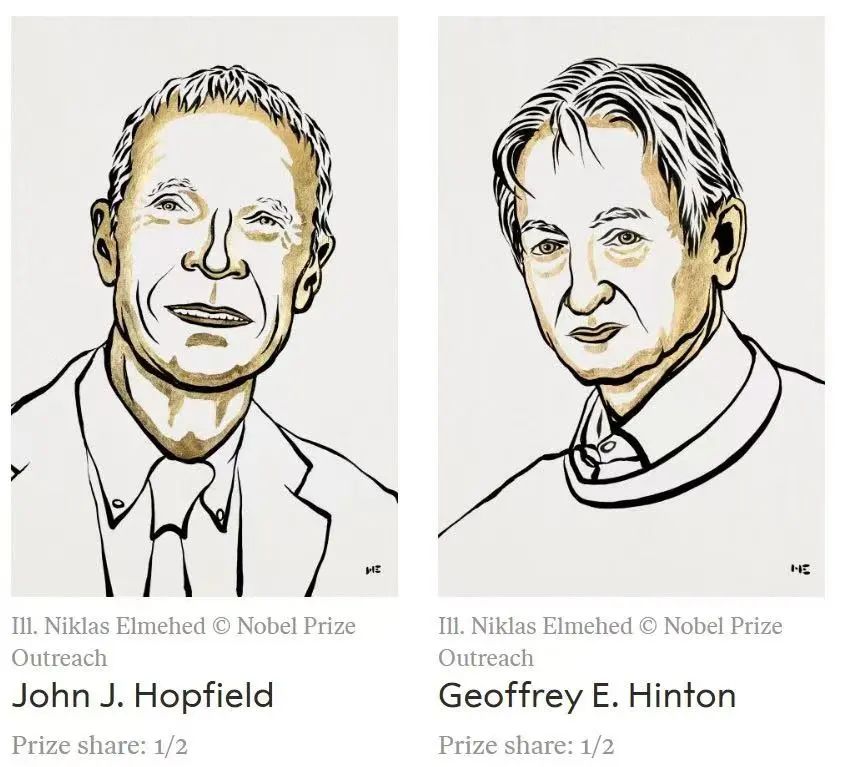
this is picture number 1
🤖 This image features two illustrated portraits accompanied by names and credits. The left figure is John J. Hopfield, and the right figure is Geoffrey E. Hinton. Their illustrations likely signify their contributions and recognition in a professional or academic field. The text mentions a "Prize share," suggesting they might be recipients of a significant award or honor, such as a Nobel Prize.
这张图片展示了两幅插画肖像及其名字和版权信息。左边的图像代表John J. Hopfield,右边的是Geoffrey E. Hinton。这些插画可能象征着他们在某个专业或学术领域的贡献和认可。文中提到的“奖项份额”暗示他们可能是某个重要奖项或荣誉(例如诺贝尔奖)的获得者。

this is picture number 2
🤖 This image displays a famous equation from statistical mechanics, S=k⋅logW, which is associated with Ludwig Eduard Boltzmann, given the year 1877. This equation relates the entropy (S) of a system to the number of possible microstates (W), with k being the Boltzmann constant. It is a fundamental principle in the field of thermodynamics and statistical mechanics.
这张图片展示了一条著名的统计力学方程式 S=k⋅logW,并与Ludwig Eduard Boltzmann 相关,年份为1877。这个方程式将一个系统的熵(S)与可能的微观状态数量(W)联系起来,其中 k是玻尔兹曼常数。这是热力学和统计力学领域的基本原理。
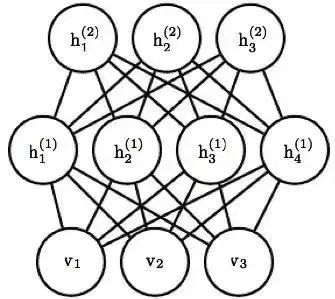
this is picture number 3
🤖 This image depicts a diagram of a neural network, specifically a restricted Boltzmann machine (RBM). The network consists of visible units (v1,v2,v3) and hidden units (h1(1),h2(1),h3(1),h4(1) in the first layer, and h1(2),h2(2),h3(2) in the second layer). The connections between these units illustrate how the input data (visible units) are connected to the hidden units in a hierarchical manner, common in machine learning and artificial intelligence applications.
这张图片展示了一个神经网络的图示,特别是一个受限玻尔兹曼机(RBM)。网络包括可见单元 (v1,v2,v3) 和隐藏单元 (h1(1),h2(1),h3(1),h4(1)在第一层,h1(2),h2(2),h3(2) 在第二层)。这些单元之间的连接展示了输入数据(可见单元)如何以分层方式连接到隐藏单元,这在机器学习和人工智能应用中很常见。
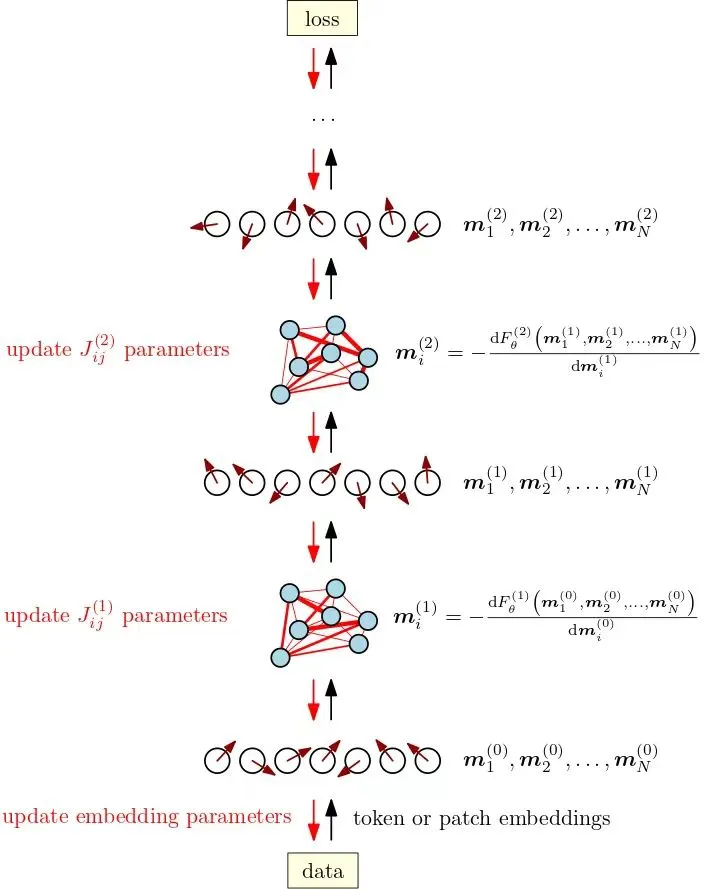
this is number 4
🤖 This image appears to illustrate a process in a machine learning or neural network training workflow. It details the sequence of updating parameters (Jij) in different layers and embeddings, from data input to calculating loss. The process starts with the data, which goes through an embedding layer to tokenize or create patch embeddings. These embeddings pass through various layers where parameters are updated, and computations are performed. The end goal is to minimize the loss.
这张图片似乎展示了机器学习或神经网络训练流程中的某个过程。它详细描述了从数据输入到计算损失的各层参数(Jij)更新和嵌入的顺序。该过程始于数据,通过嵌入层进行标记或创建补丁嵌入。这些嵌入通过各层,其中参数得到更新,计算得以进行。最终目标是最小化损失。
ising model is used to explain transformer in picture number 4, could you add more your explaination of this picture
在第4张图片中,对变压器的解释使用了伊辛模型,你能对这张图片进行更多的解释吗
🤖 Sure, I'll expand on the explanation with a focus on the Ising model and how it relates to transformers in the context of the image.
This image illustrates the application of the Ising model to explain the workings of a transformer, a type of neural network architecture commonly used in natural language processing and other machine learning tasks. The Ising model, traditionally used in statistical mechanics to represent magnetic systems, is adapted here to illustrate how parameters and interactions in the model can represent and process data through different layers of the transformer.
1.Data Input and Embeddings (bottom layer):
- The process begins with the input data, which is tokenized or split into patches.
- These tokens or patches are converted into embeddings, which serve as the input features for the model.
2.Update Embedding Parameters:
- The embeddings are passed through multiple layers, where their respective parameters are updated iteratively.
- In each layer, the embeddings interact with each other, similar to the interaction between spins in the Ising model.
3.First Hidden Layer ( mi(1) ):
- The first set of hidden units mi(1) is computed based on the interactions (analogous to spin interactions in the Ising model).
- The parameters Jij(1) are then updated, which can be viewed as adjusting the weights of the connections between neurons.
4.Second Hidden Layer ( mi(2) ):
- The process continues to the next hidden layer mi(2) with updated parameters Jij(2).
- This hierarchical interaction reflects how information is progressively processed and refined at each layer, akin to energy state updates in the Ising model.
5.Loss Calculation (top layer):
- The final outputs are used to compute the loss, indicating the difference between the model's prediction and the actual target.
- The loss value guides the adjustments to the parameters during training, aiming to minimize errors and improve accuracy.
In summary, this image uses the Ising model as a metaphor to illustrate the complex interactions and parameter updates within a transformer model. The analogy helps to conceptualize the dynamics of data processing through layers of neural networks, emphasizing the iterative optimization and hierarchical structure.
这张图片使用伊辛模型来解释变压器(Transformer)的工作原理,这是一种常用于自然语言处理和其他机器学习任务的神经网络架构。传统上用于统计力学中表示磁系统的伊辛模型在这里被改编来说明模型中的参数和交互如何通过变压器的不同层来表示和处理数据。
1.数据输入和嵌入(底层):
- 过程从数据输入开始,这些数据被标记化或分割成补丁。
- 这些标记或补丁被转换为嵌入,作为模型的输入特征。
2.更新嵌入参数:
- 嵌入通过多个层,每一层的参数都会被迭代更新。
- 在每一层中,嵌入彼此交互,类似于伊辛模型中的自旋交互。
3.第一隐藏层 (mi(1) ):
- 计算第一组隐藏单元 mi(1),基于交互(类似于伊辛模型中的自旋交互)。
- 参数 Jij(1) 随后更新,这可以看作是调整神经元之间连接的权重。
4.第二隐藏层 (mi(2) ):
- 过程继续到下一隐藏层 mi(2),更新参数Jij(2)。
- 这种层次交互反映了信息在每一层中逐步处理和精炼,就像伊辛模型中的能量状态更新一样。
5.损失计算(顶层):
- 最终输出用于计算损失,指出模型预测与实际目标之间的差异。
- 损失值引导训练期间参数的调整,旨在最小化错误并提高准确性。
总之,这张图片使用伊辛模型作为比喻来说明变压器模型内部的复杂交互和参数更新。这种类比有助于概念化通过神经网络层的数据处理动态,强调迭代优化和层次结构。
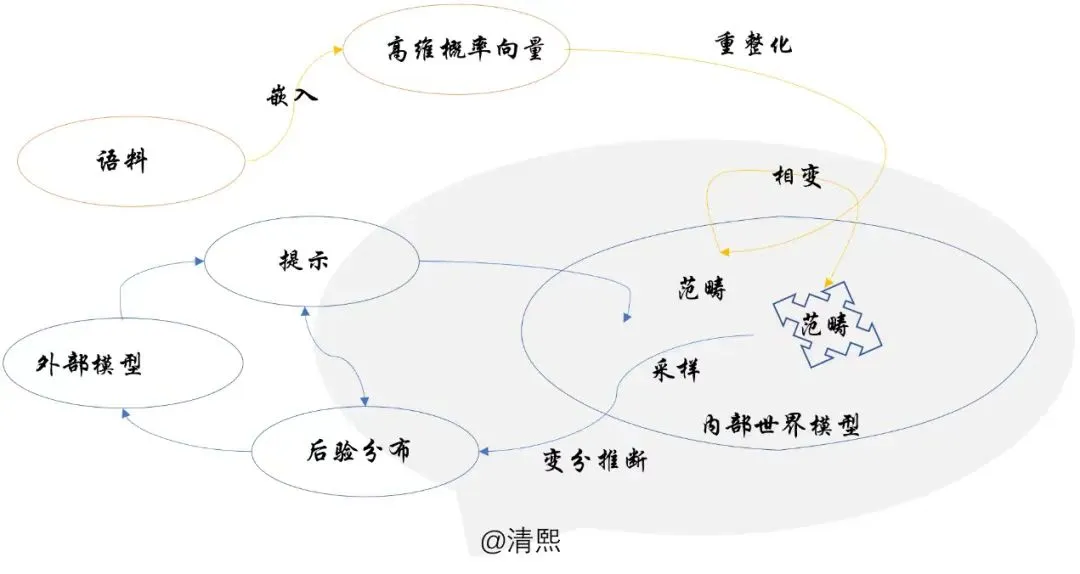
this is picture number 5
🤖 This image contains a flowchart with various interconnected nodes and directional arrows, indicating a process or a conceptual framework likely related to machine learning or data processing. The nodes are labeled in Chinese, suggesting steps or components within the process. Here is a breakdown of the flowchart:
•语料 (Corpus): The starting point, likely representing the raw linguistic data.
•嵌入 (Embedding): The corpus is embedded into high-dimensional vectors.
•高维概率向量 (High-dimensional probability vectors): These vectors are then reorganized (重整化) or transformed (相变).
•范畴 (Category): The process involves categorization and interaction with an "internal world model" (内部世界模型).
•采样 (Sampling): Sampling is a crucial step within categorization.
•变分推断 (Variational inference): Used for probabilistic and statistical inference from the data.
•后验分布 (Posterior distribution): The results feed into the posterior distribution for further analysis.
•外部模型 (External model): Interacts with the process; external model information might be used for prompting (提示) further actions.
This process integrates statistical modeling, embedding, and inference techniques, indicating a comprehensive approach to analyzing and processing data.
这张图片包含一个流程图,有多个相互连接的节点和方向箭头,表示一个过程或概念框架,可能与机器学习或数据处理相关。节点上的标签是中文,暗示了该过程中的步骤或组件。以下是流程图的细分:
•语料:起点,可能代表原始的语言数据。
•嵌入:语料被嵌入到高维向量中。
•高维概率向量:这些向量然后被重整化或相变。
•范畴:过程中涉及分类和与“内部世界模型”的交互。
•采样:采样是分类中的一个关键步骤。
•变分推断:用于从数据中进行概率统计推断。
•后验分布:结果反馈到后验分布中进一步分析。
•外部模型:与过程有交互;外部模型信息可能用于提示进一步的行动。
这个过程结合了统计建模、嵌入和推断技术,表明是一个综合的方法来分析和处理数据。
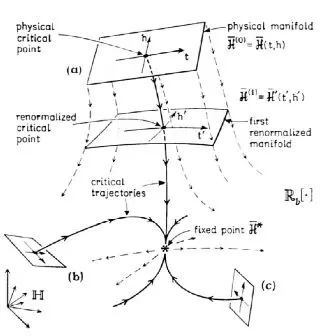
this is picture number 6
🤖 This image depicts a conceptual diagram that seems to explain a process related to renormalization in physics. Here is a breakdown of the main components:
1.Physical Critical Point:
- Represents the starting critical point in a physical system, likely within the context of phase transitions or critical phenomena.
2.Renormalized Critical Point:
- Shows the adjusted or "renormalized" critical point after applying some transformation or renormalization procedure, which simplifies the system while preserving essential properties.
3.Manifolds:
- Depicts different levels of physical ( H(0) ) and renormalized manifolds ( H(1) ), which are spaces upon which physical parameters lie.
4.Critical Trajectories:
- Arrows indicate the paths or trajectories that a system follows as it evolves from the physical critical point towards fixed points under renormalization transformations.
5.Fixed Point ( H∗ ):
- Represents a stable state where the system remains invariant under the renormalization transformations. It's a crucial concept in understanding critical behavior in systems.
6.Renormalization Operator (Rb):
- Likely represents the operator or function applied during the renormalization procedure to scale the system parameters.
This diagram is a visual tool to explain renormalization, a technique used in theoretical physics to study behaviors of systems at different scales, especially near critical points.
这张图片展示了一个概念图,似乎解释了物理学中重整化相关的过程。以下是主要组成部分的细分:
1.物理临界点:
- 代表物理系统中的起始临界点,可能与相变或临界现象有关。
2.重整化临界点:
- 显示在应用某种转换或重整化过程后的调整或“重整化”临界点,这简化了系统但保留了基本特性。
3.流形:
- 描绘了物理流形( H(0) )和重整化后流形( H(1) )的不同层次,这是物理参数所在的空间。
4.临界轨迹:
- 箭头表示系统从物理临界点向重整化转换下的不动点演变的路径或轨迹。
5.不动点( H∗ ):
- 代表在重整化转换下保持不变的稳定状态。这是理解系统在临界行为中的重要概念。
6.重整化算子(Rb):
- 可能代表重整化过程中应用于缩放系统参数的算子或函数。
这个图表是解释重整化的视觉工具,重整化是一种在理论物理学中用于研究系统在不同尺度上行为的技术,特别是在临界点附近。
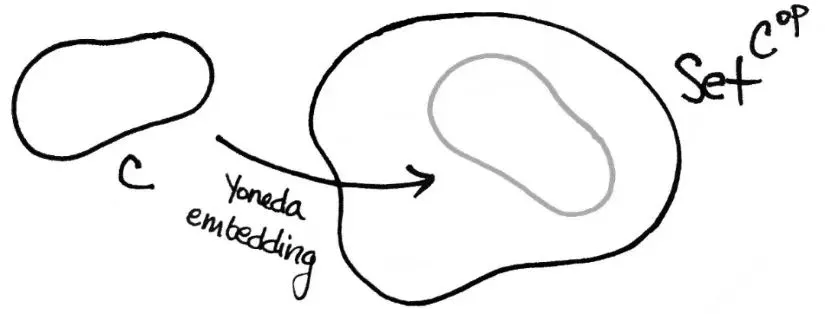
this is number 7
🤖This image represents a conceptual diagram related to category theory in mathematics. It illustrates the Yoneda embedding, an essential concept in category theory.
•C:
Represents a category, which is a collection of objects and morphisms (arrows) between them, satisfying certain properties.
•Set^C^op:
Denotes the category of contravariant functors from the category C to the category of sets (Set). This essentially maps objects and morphisms in a way that reverses the direction of morphisms.
•Yoneda Embedding:
The arrow indicates the Yoneda embedding, which maps an object in category C to a functor in the category Set^C^op. This embedding provides a way to represent objects of C within a functor category of presheaves, facilitating the study of C through its functor properties.
This embedding is a powerful tool in category theory, allowing category C to be understood and analyzed through the functors it represents.
这张图片展示了一个与数学中的范畴理论相关的概念图,说明了一个重要的概念——Yoneda嵌入。
•C:
代表一个范畴,这是满足某些性质的对象和态射(箭头)的集合。
•Set^C^op:
表示从范畴 C到集合范畴(Set)的反变函子范畴。这本质上是以反向映射对象和态射的方式进行映射。
•Yoneda嵌入:
箭头表示Yoneda嵌入,它将范畴 C中的对象映射到范畴 Set^C^op 中的函子。这种嵌入提供了一种通过预层函子类别来表示C的对象的方法,从而便于通过它的函子性质来研究 C。
这种嵌入在范畴理论中是一个强有力的工具,使得可以通过它所表示的函子来理解和分析范畴 C。
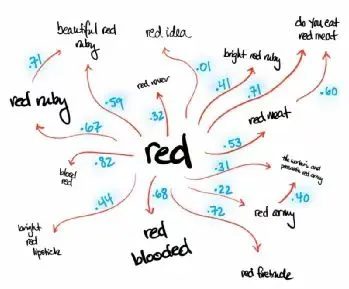
and number 8
🤖 This image appears to be a mind map centered around the word "red." It includes various phrases and concepts associated with "red," each linked with arrows and accompanied by numerical values, which likely represent some form of correlation, similarity score, or strength of association. Here are some of the connections depicted:
•"beautiful red ruby" with a score of .71
•"red idea" with a score of .01
•"bright red ruby" with a score of .47
•"do you eat red meat" with a score of .60
•"red meat" with a score of .53
•"the warm and passionate song" with a score of .20
•"red army" with a score of .72
•"red playdate" with a score of .36
•"red blooded" with a score of .68
•"bright red lipstick" with a score of .44
•"blood red" with a score of .82
•"red ruby" with a score of .67
Each phrase or concept extends from the central word "red," representing its various associations in different contexts, possibly aiding in studies of semantics, cognitive linguistics, or marketing analysis.
这张图片似乎是一个围绕“红色”一词的思维导图。它包括与“红色”相关的各种短语和概念,每个短语和数字值相关联,这些数字可能表示某种形式的相关性、相似度分数或关联强度。以下是其中一些连接:
•"beautiful red ruby" ,分数 .71
•"red idea" ,分数 .01
•"bright red ruby" ,分数 .47
•"do you eat red meat" ,分数 .60
•"red meat" ,分数 .53
•"the warm and passionate song" ,分数 .20
•"red army" ,分数 .72
•"red playdate" ,分数 .36
•"red blooded" ,分数 .68
•"bright red lipstick" ,分数 .44
•"blood red" ,分数 .82
•"red ruby" ,分数 .67
每个短语或概念都延伸自中心词“红色”,代表其在不同背景下的各种关联,这可能有助于语义学研究、认知语言学或市场分析。

number 9
🤖 This image contains a mathematical equation that appears to come from the field of machine learning, particularly related to neural networks and attention mechanisms.
The equation on the left-hand side:
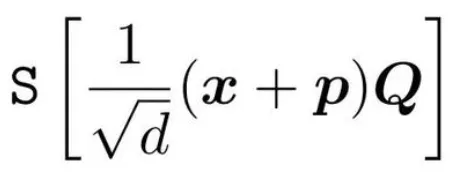
And the equation on the right-hand side:

Here's a breakdown of the components:
•x: Input data or feature vector.
•p: Positional encoding or additional feature vector.
•Q: Weight matrix.
•d: Dimensionality or scaling factor.
•QQ⊤: Possibly a self-attention matrix or another transformation related to the attention mechanism.
•softmax: A function that normalizes the input into a probability distribution.
In the context of transformers, this equation is likely part of the self-attention mechanism, which helps the model weigh the importance of different parts of the input sequence. The scaling factor 1/d is commonly used to prevent the dot products from growing too large, which the softmax function then normalizes to produce attention weights.
这张图片包含一个数学方程,似乎来自机器学习领域,特别是与神经网络和注意力机制相关的部分。
方程左边:
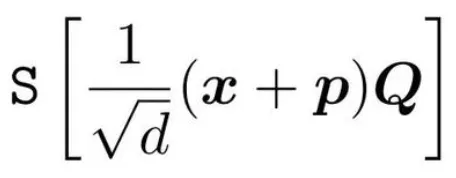
方程右边:

以下是组成部分的细分:
•x:输入数据或特征向量。
•p:位置编码或额外的特征向量。
•Q:权重矩阵。
•d:维度或缩放因子。
•QQ⊤:可能是自注意力矩阵或与注意力机制相关的其他变换。
•softmax:一个将输入归一化为概率分布的函数。
在变压器的上下文中,这个方程可能是自注意力机制的一部分,帮助模型权衡输入序列不同部分的重要性。缩放因子 1/d常用于防止点积变得太大,之后 softmax 函数则将其归一化以生成注意力权重。
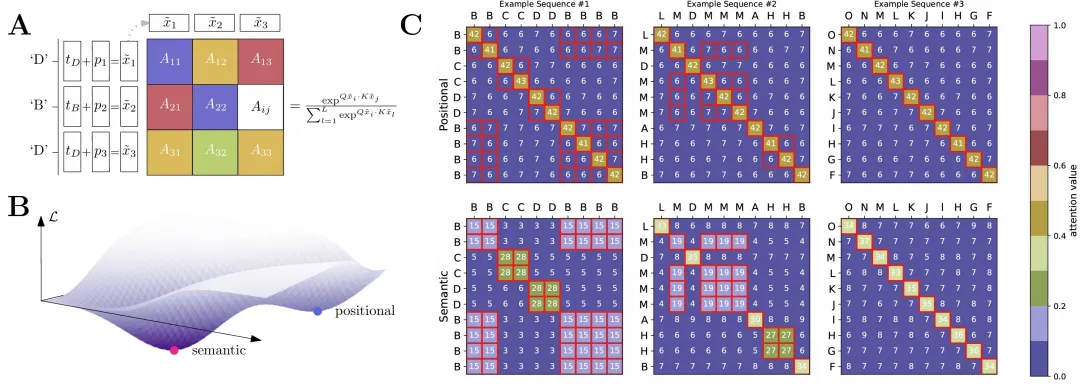
number 10
🤖 This image is divided into three main sections labeled A, B, and C, each contributing to the explanation of some data analysis or machine learning concept related to attention mechanisms.
Section A
Illustration of Attention Mechanism:
•Inputs and Summation:
○Inputs (D, B, D) are transformed through positional encoding ( p) and temporal encoding ( t), resulting in encoded vectors x~1,x~2,x~3.
○The resulting encoded inputs are used to create an attention map represented by matrix Aij.
•Scaled Dot-Product Attention:
○The formula at the right side shows how the attention weights Aij are calculated. These are usually based on the scaled dot-product of the encoder outputs.
○Each element Aij in the attention map is computed using the softmax function of the scaled dot-product of the query Q and key K vectors.
Section B
Semantic and Positional Interplay:
•This section visualizes the interplay between positional and semantic information in a 3D plot.
○Positional and Semantic: Axes indicating two different types of information carried by the input tokens.
○Loss Surface: The plot likely represents a loss landscape ( L ) which changes based on the balance of positional and semantic information.
Section C
Attention Maps for Example Sequences:
•Heatmaps for Different Example Sequences:
○Three sets of heatmaps (Example Sequence #1, #2, #3) shown using blue, U-shaped structures, with color-coded values indicating attention strength.
○Sequences such as letters or numbers run along the axes of each heatmap.
○Attention Values: Colormaps to the right indicate the attention value of normalized scores (where higher attention values indicate a stronger focus by the model on those elements).
•Positional vs. Semantic Representation:
○Positional Heatmaps: Display how attention is distributed purely based on the positional context of the tokens.
○Semantic Heatmaps: Show attention distribution considering the semantic context.
Summary
•Attention Mechanism in Transformers: The sections collectively help illustrate how attention mechanisms in transformer models balance positional and semantic information across sequences.
•Visualization Techniques: Both 3D plots and heatmaps provide insight into transformation and influence of input data, primarily with a focus on enhancing interpretability for language models.
这张图片分为三部分,A,B 和 C,各自说明了与注意力机制相关的数据分析或机器学习概念。
部分 A
注意力机制图解:
•输入和加法:
○输入(D,B,D)经过位置编码( p )和时间编码( t )后,生成编码向量x~1,x~2,x~3。
○这些编码的输入用于创建一个表示为矩阵 Aij的注意力图。
•缩放点积注意力:
○右侧的公式展示了如何计算注意力权重 Aij,通常基于编码器输出的缩放点积。
○注意力图中的每个元素 Aij是通过查询向量 Q 和键向量 K 的缩放点积的软最大值函数计算的。
部分 B
语义和位置之间的交互:
•这一部分通过3D图展示了位置信息与语义信息之间的交互。
○位置信息 和 语义信息:表示输入 tokens 中两种不同信息类型的坐标轴。
○损失曲面:图中显示的可能是损失景观 (L),基于位置和语义信息的平衡改变的曲面。
部分 C
示例序列的注意力图:
•不同示例序列的热力图:
○三组热力图(Example Sequence #1, #2, #3)在蓝色 U 形结构中展示,颜色编码的数值指示注意力强度。
○每个热力图的坐标轴上排列着字母或数字序列。
○注意力数值:右侧的颜色图表示归一化分数的注意力数值(注意力数值越高表示模型对这些元素的关注度越强)。
•位置与语义表示:
○位置热力图:显示注意力如何仅基于 tokens 的位置上下文进行分布。
○语义热力图:显示考虑语义上下文的注意力分布。
总结
•变压器中的注意力机制:这些部分共同说明了变压器模型中的注意力机制如何在序列中平衡位置和语义信息。
•可视化技术:3D图和热力图提供了输入数据的转化和影响的见解,主要是为了增强语言模型的可解释性。
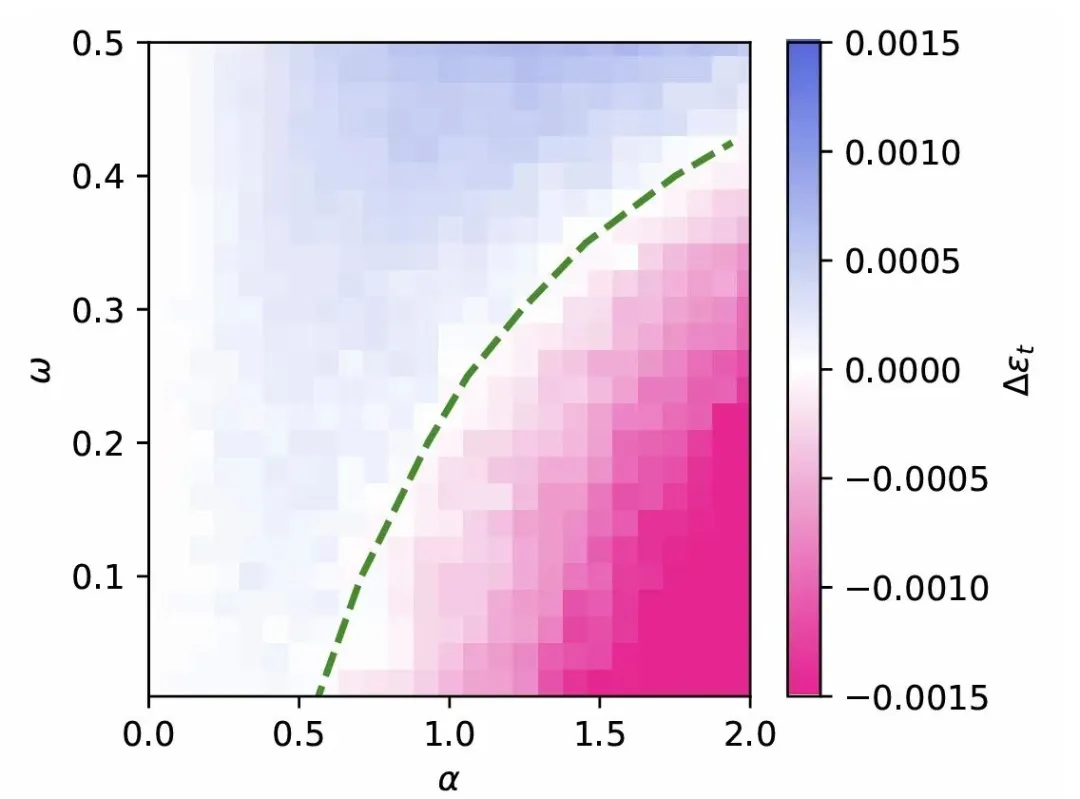
number 11
🤖 This image is a heatmap that represents data across two variables, αα and ωω, with a color gradient indicating the value of a third variable Δϵt. Here’s a breakdown of the elements:
1.Axes:
X-axis (α): Represents a variable range from 0 to 2.
Y-axis (ω): Represents another variable range from 0 to 0.5.
2.Color Gradient:
The color bar to the right shows the range of Δϵt values, with blue indicating lower values and pink/red indicating higher values. The gradient ranges from approximately -0.0015 to 0.0015.
3.Heatmap:
The heatmap itself is a visual representation of Δϵt values for the corresponding α and ω pairs. Each pixel's color reflects the value of Δϵt at that point.
4.Dashed Line:
○A green dashed line suggests a boundary or threshold within the data, indicating a region where there's a significant change in behavior or a phase transition.
This heatmap can be used to analyze how Δϵt varies with α and ω, helping to identify patterns, trends, or critical points in the data.
这张图片是一个热图,表示在两个变量 α 和 ω上的数据,颜色渐变指示第三个变量 Δϵt的值。以下是元素的详细信息:
1.轴线:
X轴 (α):表示从0到2的变量范围。
Y轴 (ω):表示从0到0.5的另一个变量范围。
2.颜色渐变:
右侧的颜色条显示 Δϵt值的范围,蓝色表示较低值,粉红或红色表示较高值。渐变范围大约从 -0.0015 到 0.0015。
3.热图:
热图本身是 Δϵt值针对相应的α和ω对的可视化表示。每个像素的颜色反映该点 Δϵt的值。
4.虚线:
绿色的虚线暗示数据中的边界或阈值,表明某个区域内有显著变化或相变的行为。
该热图可用于分析 Δϵt随α和ω的变化,以帮助识别数据中的模式、趋势或临界点。
本文转载自 清熙,作者: 王庆法
















